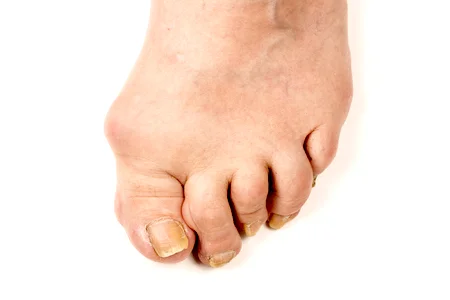Table of Contents
What Is Arthritis?
Arthritis can cause pain in your feet as well as your knees, fingers and wrists. Arthritis is inflammation of a joint and is very common in the small joints of the ankle and foot, especially in the big toe and midfoot.
Degenerative arthritis is a condition that slowly wears away joints (the link where bones meet and move). In the beginning, you may notice that the affected joint seems stiff. It may even ache. As the joint lining (cartilage) breaks down, the bones rub against each other, causing pain and swelling. Over time, bone spurs (small pieces of rough or splintered bone) develop, and the joint’s range of motion becomes limited. But movement doesn’t have to cause pain. The effects of arthritis can be reduced. Talk with your doctor about developing a treatment plan to meet your needs.
Which Joints Are Affected?
The Big-Toe Joint
Rear or Midfoot Joints
Types of Arthritis
Osteoarthritis
Rheumatoid arthritis
Gout
Arthritis from Trauma
Arthritis can result from trauma to the foot or ankle such as fractures and dislocations.
Arthritis Symptoms
- Pain with motion
- Tenderness
- Joint swelling
- Joint warmth
- Difficulty walking
Treating Arthritis
Physical Exam
Imaging Tests
Medications
Surgery
To ease movement and reduce pain, your doctor may trim damaged bone. If arthritis is severe, the joint may be fused or removed.
If the bone is not damaged too badly, your doctor may simply shave away bone spurs. Any excess growth related to a bunion may also be trimmed.
Fusing Joints
After Surgery
As You Heal
After surgery, you’ll be told how to care for your incision and how soon to begin walking on the foot. Until the foot can bear weight, you may need to walk with crutches or a cane.
For surgery on the big toe, your foot may be splinted to limit movement for several weeks. Despite this, you should be able to walk soon after surgery.
For surgery on rear or mid-foot joints, you may need to wear a cast or surgical shoe. These joints are fairly large, so full recovery may take a few months. Once the bone has healed, any staples or screws may be removed.
Conclusion
- Custom-fitted orthotics can ease pain and minimize pressure on the foot.
- Reduce excess weight to relieve joint stress.
- Switch to low-impact exercise like swimming or biking.
- Physical therapy can increase range of motion, flexibility and muscle strength.
- Take anti-inflammatory medication to relieve inflammation.



